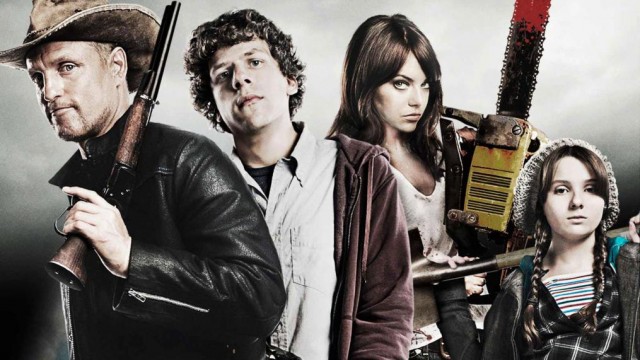Trying to define what qualifies as a horror movie is an impossible task, so naturally several people have tried to do it. Noel Carroll’s famous definition hinges on an audience disgusted with the film’s subject and a sense of threat. “Fear of the unknown” is also a phrase that crops up a lot. While I doubt you can truly have a hard line definition on this, I do know one thing, despite its zombie filled center Zombieland is definitely not horror.
The first thing it does is lay down rules. Rule #1 for avoiding zombies is having good cardio. Rule #3 says to be cautious around bathrooms. Rule #18 advises you limber up before action. Zombieland acts as proof that horror and comedy are inches away from each other, and all it takes to go from the horror to the latter is limiting what the protagonists deal with. Once zombies have rules, zombies become safe, and even a plight as harrowing as the end of the world and the potential extinction of the human race becomes a backdrop for comedy, romance, and general fuzzy feelings about strangers coming together to form a family.
The protagonists are altered to fit this too. Jesse Eisenberg’s Colombus, with his dorky mannerisms and lovelorn demeanor, is far from the macho survivalist we expect to lead in such a setting. He’s fills a perfect slot for a movie who’s endpoint is less doomed survival and more about finding love and a couple of new friends to with it. In this case, the love is Wichita (Emma Stone) a character with just enough shading to make her role not a waste. The makeshift family is then bookended with the paternal Tallahassee (Woody Harrelson) and the young Little Rock (Abigail Breslin) both of whom obviously reject such notions of friendship and camaraderie until third act learning moments say they shouldn’t. It’s an incredibly straightforward movie in terms of its character arcs, one that would be forgotten if it wasn’t for, well, the zombies.
There’s such an extra charge to be gained from this movie by the contrast of typical comedy/romance tropes with the bleak setting. A lot of the humor comes from seeing zombies defanged to be sure. They get pianos dropped on them, hit by amusement park rides, and most of the time just shot up in several different badass ways. Not only that, but the tired character arcs become so much more effective when they let just the tiniest amount of drama slip in. The movie takes such a nonchalant stance towards the apocalypse, it sets up these perfect sucker punches of scenes. Colombus realizing his parents have died, realizing the truth about Buck’s son, when the moments between him and Wichita switch from typical banter-flirting to an honest connection. In this case the setting is effective. Though the characters never seem to fully let the innate horror of a post-society set in, the darkness constantly at the edges of the film allow for a nice variety and texture in tone.
Zombieland came at a crucial point in the zombie “fad” kicked off by Snyder’s Dawn of the Dead, a supposed that is very clearly crystallizing as more than just that. Zombieland positions its setting as something more than just a vehicle for telling one particular kind of story. Though its story and characters are familiar, even without the zombies it has enough strength in execution to stand the test of time. Just look at the chaotic fun of the convenience store scene, or the long, hilarious sequence set in Bill Murray’s house. The unique way it blends genre catapulted it to a $102 million box office haul, and will probably let it stand the test of time too.

